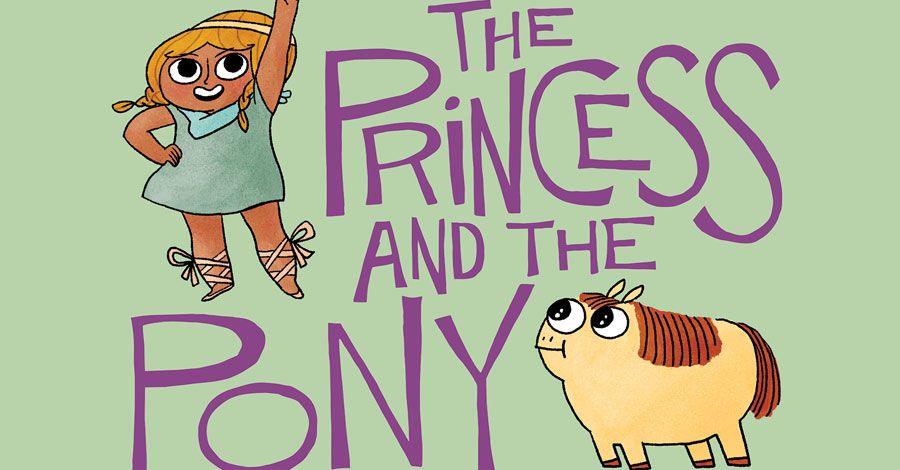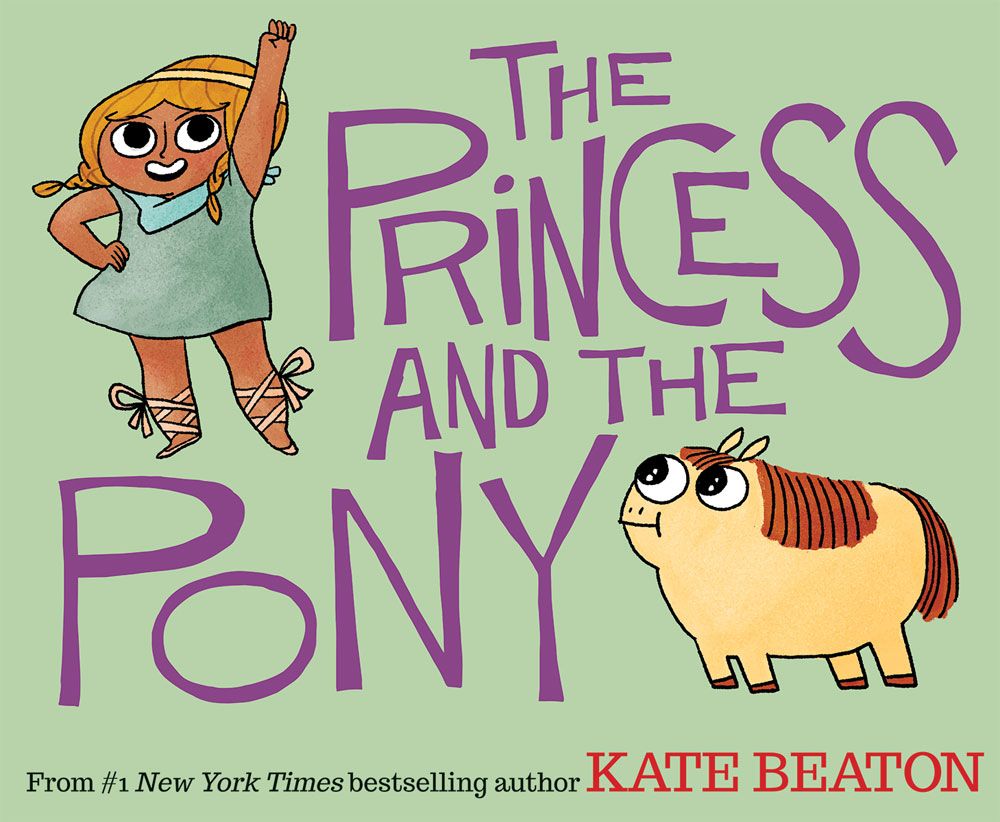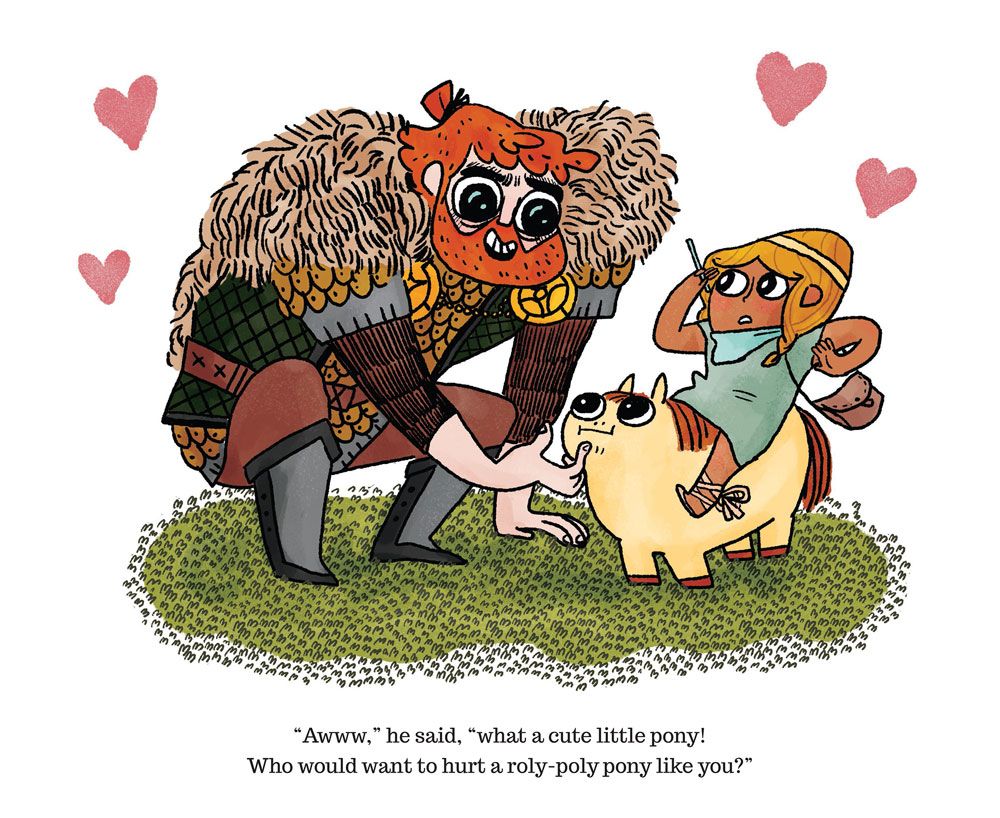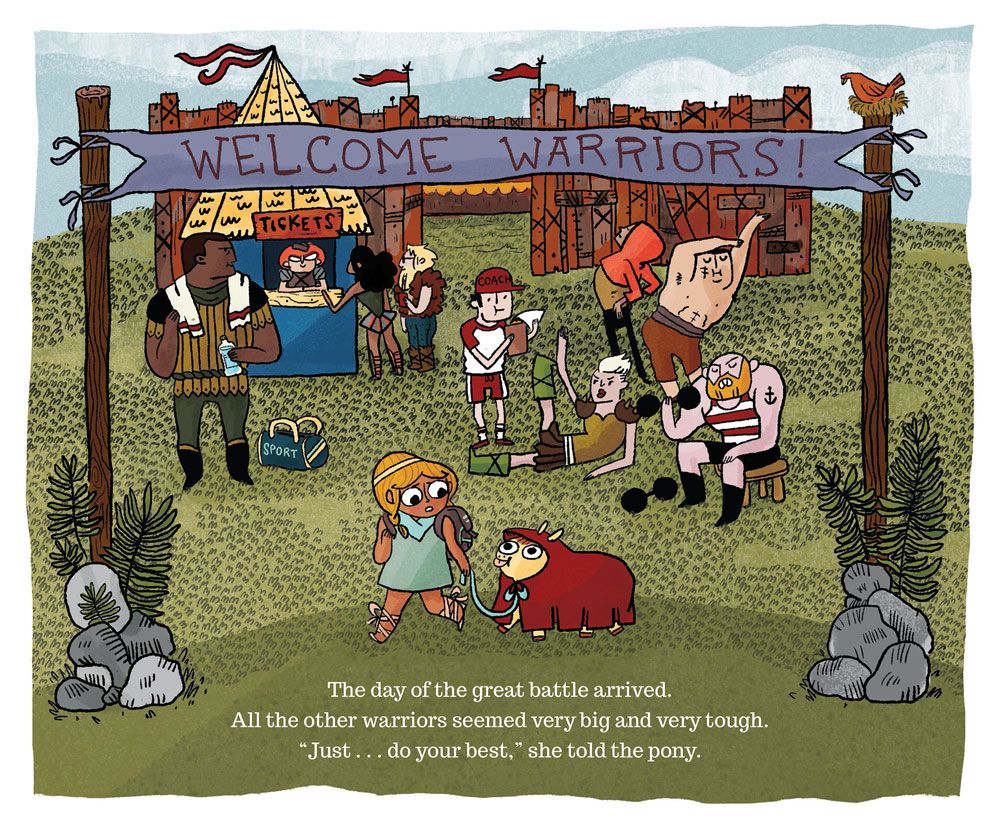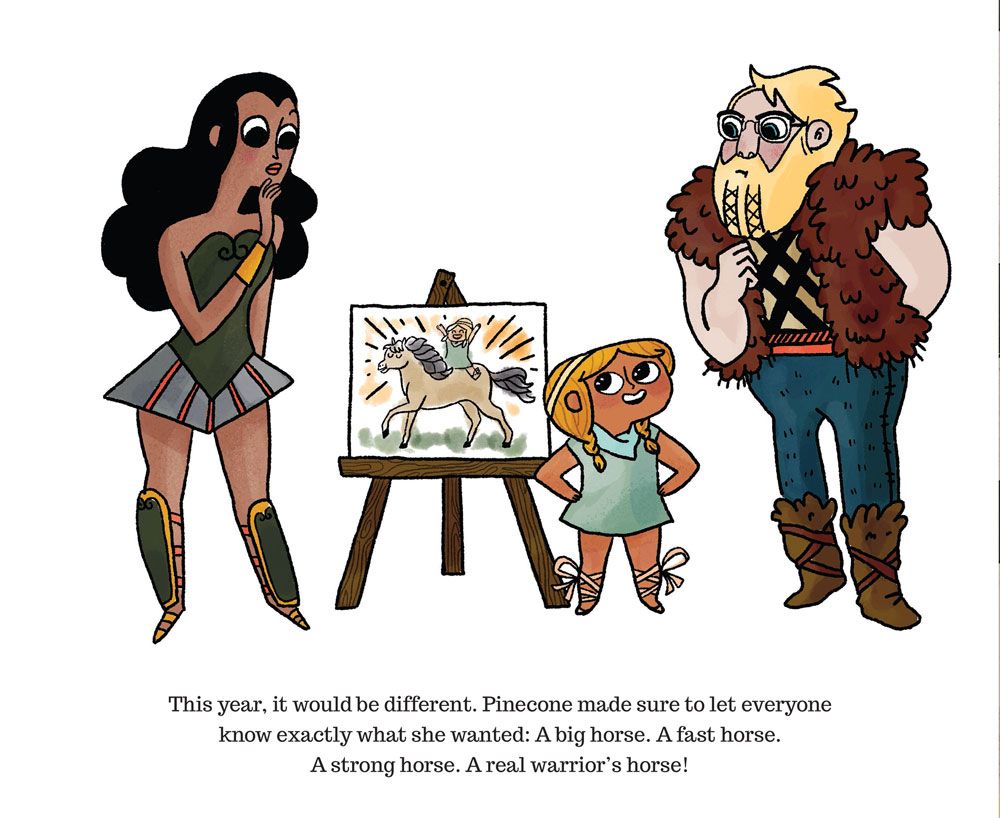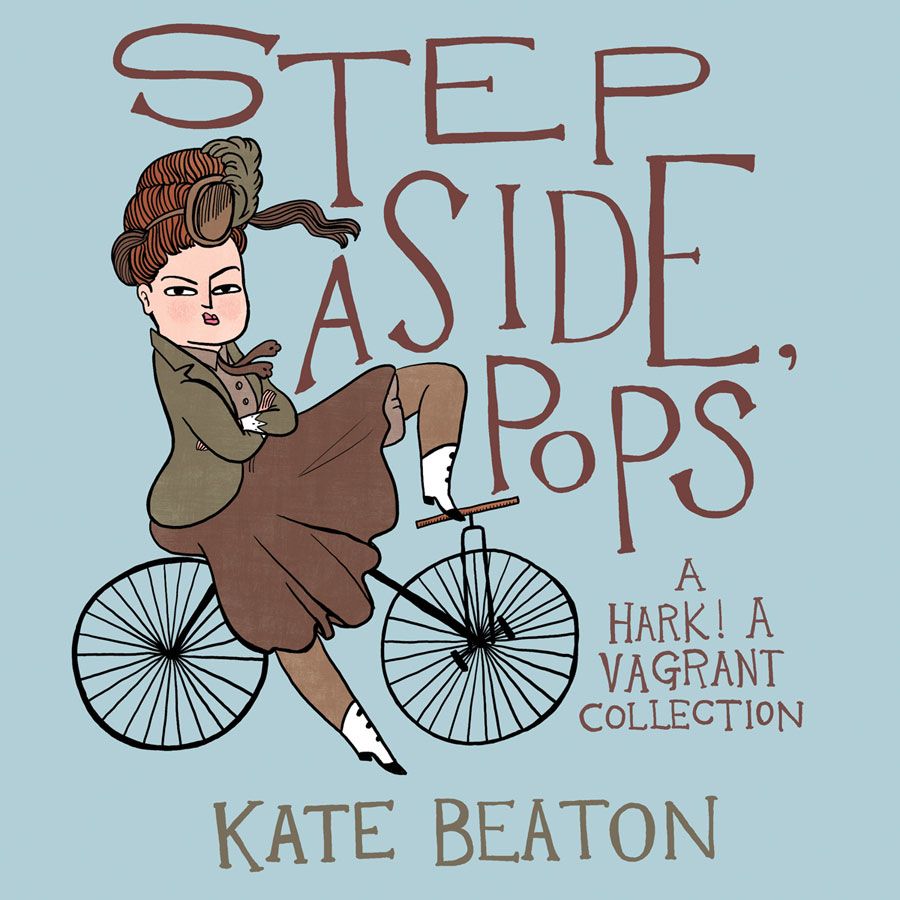Kate Beaton is one of the smartest, funniest cartoonists on the web, and its a humor that's found success in print as well. When "Hark! A Vagrant" was collected in 2011, it was a New York Times bestseller. Her comics have appeared in "The New Yorker" and dozens of other publications, and in the recent "Drawn & Quarterly 25," Beaton was celebrated by the award winning author -- and great Canadian -- Margaret Atwood.
While many people think of her as the cartoonist who hilarious skewers Nikola Tesla, Jane Eyre and other historical and literary figures, for others, it's all about The Fat Pony. Long one of Beaton's most famous characters -- something that even she can't quite explain -- the character has appeared in a handful of comics, and even been a guest star on an episode of "Adventure Time." Yet despite its popularity, the character doesn't really do much of anything. So of course it's the co-star in Beaton's Scholastic-published kid's book, "The Princess and The Pony."
CBR News: Where did "The Princess and The Pony" come from?
Kate Beaton: Well, we -- I say we, the royal "we" [Laughs] -- wanted to make a book about the pony because it seemed like an obvious type of character to start with as far as my oeuvre goes. Kids have already responded to it well. I had met kids who liked it already whose parents would let them read that comic -- but the rest of them they weren't allowed to read. He's round, wide-eyed and really looks like a kids character anyway. I wanted it to be about the pony and I wanted it to be about a little girl as well. She's a princess, because I loved princesses when I was little. I think that if you're going to write a princess story, it just depends on what it's about. It doesn't have to be about a prince and the dresses and all that stuff. It can be about whatever. Because the pony is an inactive character a lot of the time, the best thing to do would be to put as much action around him as possible. And so you have this kingdom of warriors and rollicking battles around this very almost stationary character who doesn't feel like he belongs there. And I wanted to tie it into real kid experiences, so it starts with a birthday, which is an important day.
We're about the same age, and it was after we were kids that this whole princess industry started. But princesses were always a thing and always popular.
They were always a thing that girls, especially, were marketed towards, but I think it's also a thing that kids have always been drawn towards. They're going to be a young character, so kids relate to them.They're a character who has a lot of power to make their own choices, and people listen when they talk and they're allowed to pick what they want to do for the day and maybe even what they want to eat for dinner. They get to do stuff that real kids don't, but they're not old like a king or queen, so kids can put themselves in those shoes. I think that's the real draw for princesses for me.
At the same time, if you didn't say that she was a princess, there's no reason to think that she's a princess.
I said her name was Princess Pinecone, and I joked with different people that maybe she named herself that. You know how kids do that. She's not really a princess, but she's like, this is my name. Kids will often tell you who they are and who they're pretending to be and who they want to be for that day. You play along with that. It's an identity that she has. It doesn't drive the story, but she's a princess.
Was the experience of making the book very different from making comics?
Oh, yeah. It's a whole different audience. I like doing work for kids because it's a different mindset to get into. The difference is that they're coming from a whole different set of experiences. Some things, they're experiencing for the first time. Other things they're just experiencing on a different level. They don't have the same backlog of memory that adults have, so they can't pull nostalgia with them. If something is fun, you have to make it fun. You don't talk down to them, but they are at a baser level of experiencing things so it's a different mode to operate in.
You can't use detachment or irony.
They believe you. You can use irony, but it has to be very broad and obvious. They're not jaded enough to be like, yes, I love irony. They're like, no, give me farts. [Laughs] Give me poo. Poo is amazing.
Based on your approach to drawing strips, you didn't seem to have as big a learning curve stylistically in making this book.
The art in the book is more than I normally do in the strips, but it's still pretty simple. I think that simplicity is pretty key in bringing out emotion and what I'm trying to say. I have experience in panelling things out, so instead of like a three-panel comic, this is a forty-panel comic, I guess.
Was there a lot of rewriting and redrawing involved in making the book?
It was rewritten a lot. I didn't expect to be amazing at it right away -- and I wasn't. The story was in pretty good shape when I sent it to them as a dummy and they accepted it, but it still needed to be reworked and edited. The art needed to be tidier. The characters needed to be more defined. That kind of thing. It took a little while.
In a gag comic -- especially a historical reference one -- I'm pulling from something that exists, that is whole. In this book, I had to create a whole thing. I can't just allude to something. I had to tell the whole story because it only exists between these two pages. There's no reference for it elsewhere. It was a different thing than I'm used to, for sure.
The gag of the book is that Princess Pinecone wants a great warrior pony, but she gets the fat pony -- which as fans of the comic know, is a great warrior and assassin.
Oh, yeah, he is. There's a lot going on there. [Laughs] But he's never an active one. That's part of the challenge of writing the book. The character is all of those things, but doesn't really do much actively.
He ends up upside down at one point, and farts, and that's about it.
And still is the champion of the day!
Why do you think the pony has become so popular and people have responded to it?
I don't know. It's round and it keeps getting rounder. From the beginning, it has always been very popular. I think that it's such a blank slate that people project into it whatever. It looks a little like a pig, too, which is endearing, I suppose. You root for the misshaped pig-like horse. You want it to come out on top. I don't know. It's one of those things that I've never really been able to explain. I've drawn other things that have googly eyes and are round, but they don't get the same response as this tiny pony
If you've ever seen someone see a tiny pony in real life, it's like they just saw what it means to be alive for the first time. It's amazing. I've seen it a few times because I always make a mental note whenever I'm near a small horse, I guess. Everybody is like, oh my God, look at this tiny horse! There's nobody who's like, let's not look at this horse. Everybody's like, let's immediately go to this horse and love it and ask the owner if we can have it. [Laughs] There's something about them. It's this miniature thing, and everybody's heart just immediately melts.
Are you planning to make more kids books?
I am making more kids books! I have a two book deal, so I'm working on the second book now. It's a different story but it's going to be a lot of fun, I hope.
You also have a new collection of comics coming out this fall, "Step Aside, Pops!" Is this a collection of what you've been posting online in recent years?
There was actually too much to fill the book, so they had to cut some comics out. Some of them are the big, long ones that are meandering, like my fever dream comics. We had to cut a few of those. They just took up too many pages and were too weird.
But yeah, it's just comics from the site. It's been a long time coming, and I'm really proud of it. There's a lot more feminist material in it. There's maybe more pop culture stuff. It's not exactly the same as the first one. There are longer ones and more sketchy ones and a bit more experimentation than the first one, I think.
I was going to ask, because since the first book was released, you've really seemed to make a point of experimenting, trying different things and different approaches.
I guess so. I think it's just growing as an artist, though it's not really conscious. Just me going, what do we do now? What's interesting to me now? For a while, I didn't do any history stuff, and I want to come back to it because it's a thing I like to do. But I was like, I'm going to exercise some other muscles in my brain. I think that's pretty natural as an artists growing. You can't stay stationary too long.
How much of what you're reading right now is research?
I actively read about things I don't know about now, not looking to make a comic, but to fill my memory bank with ideas that could be a comic. My main areas of knowledge are Canadian history, British history, American history of a certain kind, because I studied it in school and you're exposed to so much growing up. My audience is from everywhere, and people love it when you represent them a little bit. You get someone who's like, make a Chinese history comic, or a Mexican history comic. Because they're like, I love this and I want to share it and I'd love it if you loved it, too. That's what being a fan of anything is. They want you to love it as much as they do. And not just like nations, but political or military history or science history or philosophers or archeologists. There are so many little kingdoms of fandoms.
The comic on my website right now is about gravestone iconography and how it shifted over time to reflect people's changing views of death. All the grave stoners are like, yes! [Laughs] Finally, grave stone comics! It is interesting stuff -- check out the link and read that paper.
You realize that the people reading your comic represent a whole swath of interests and backgrounds. The more you listen to them and where they're coming from and what they want to see, then you're just enriching your own life and your own brain and your own personal knowledge. So I'm always reading, but nothing is guaranteed to be a comic. I've read lots of books that don't become a comic, but they go in my head and in my file and maybe someday I'll think of something for that, but not this time. Sometimes it's like, here's an angle, and sometimes it is interesting, but you still can't make a comic. No guarantee. It's a lot of reading for sure.
What are your working habits? Do you keep a sketchbook?
I am one of those people who is always reading and making notes. I feel like I'm always reading, which might explain why the drawing is not, well, they're not in the Louvre. [Laughs] They're very serviceable as cartoons. I do keep a sketchbook. I don't draw in it as much as I should, I think. If my comic wasn't a new thing all the time, I probably would be drawing more, but every time I start a new one, it's from scratch. What it's about is the most important thing to fill in the blank about.
You post a number of comics on Twitter about family life. They have a different tone and approach from your other comics. Do you think of them as a separate thing?
Yes, they're quite separate. They're very much about family life and capturing little bits of that, and at the same time not giving away too much about my parents. You know them, but you don't know their history. You just know these little quips that they're saying. I'm not near my family a lot. Everybody from my end of the country is moving away as part of this depopulation of rural areas -- same as all over North America, I think. When I'm around them, I make these comics. They're really just about family love, and I hope that message that comes out. They're like second nature, almost. Things happen, and I just draw them. My family's very good about them. I think part of it is because when I'm home, I can't stop working. I can't just not work, so I draw these. I really like capturing the complete honesty of a situation because a lot of my work takes historical facts and parodies them or makes them disingenuous in some way even if they are true to the idea. There's something really refreshing about drawing something as an exercise in complete honesty.
Also it's something that a lot of people can relate to.
That's one of my favorite things as well. Sometimes as an Internet author or presence, you see how people dehumanize authors online. As if they're not real people, they're just content generators. The way that we talk to each other online can be dehumanizing sometimes. I like for my readers to think of me as a human being, and I talk about my life, and I talk about my family. I love it when people say that my mom is just like that, or, my dad is just like that, or, this reminded me of my grandma. It's nice that there's real people in this online world. You miss that almost when everything moves online. I'm part of that generation that straddles both times, where not everything was computerized, and then it was. I just want to have that human connection to people. I think that's my favorite kind of response, when people feel that they can say, he's just like my dad.
Are you interested in doing more work along those lines? Not memoir, necessarily, but that sensibility in general. "The Princess and The Pony" is, at its heart, about something very relatable and personal.
Definitely. We've all asked for something where our parents are like, hunh? But they do their best and try to get it and they put the effort in. That's what the story is about. She wants a horse and her parents are like, a horse for small girl is this, here you go. And she makes the best of it. Later on in life, the gift that grandma got you where you were like, this gift is lame, you find it in a closet when you're older and you're like, this is grandma's gift and I love grandma. The point is that they got it because they love you and they tried their best and so you make the best of it. That's what "The Princess and The Pony" is about, really. It's family and their love for one another and making the best of what you got. And how those things can have value beyond what you think they do.

